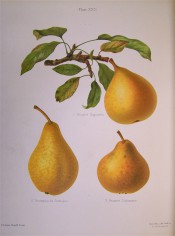Pyrus communis L.
Tree, usually with a conical crown, often thorny, the leaves oval-elliptic with scalloped margins, the flowers white in corymbs, followed by rounded to pyriform fruits, green ripening to green, brown or yellow. To 15m in the wild, but depending on variety in the cultivated pear. [RHSD, Hortus].
Horticultural & Botanical History
‘The European pear has developed mainly from the species Pyrus communis, indigenous to Europe and much of Northern Asia, particularly in the Caucasus and Turkestan. It is occasionally found in Britain though whether it is native is open to question. Certain other species of Pyrus are thought to have contributed to the evolution of the European pear but without doubt Pyrus communis is predominant. In Japan and the Far East, P. pyrifolia (syn. P. serotina) and P. ussuriensis have been the main source of the development of Asian pears. Crosses between P. communis and P. pyrifolia have occurred both naturally (in the case of ‘Kieffer’, a cultivar raised as a chance seedling in the US and at one time widely grown there and in South Africa, especially for canning) and through controlled breeding, but P. pyrifolia has played no part in the parentage of European cultivars.’ [RHSD/1999]. Pyrus communis L. var. sativa DC. is often used to denote the edible pear but the varietal name is not used in the Hortus to describe pear varieties.
The pear is an ancient garden fruit and some of the varieties described in the Hortus are of great antiquity. The older the variety the more likely it is to have many synonyms, usually related to a location or an orchardist or nurseryman with which it is particularly associated, or with the type of pear. Most synonyms of which I am aware are given here. Exceptions are minor variation in spelling or dialect variations. The number of synonyms can at times make accurate identification difficult, as overlap can occur with similar varieties. With several I have resorted to giving alternative descriptions, not being able to satisfy myself which of these pears Macarthur grew.
History at Camden Park
All of the pears grown at Camden Park in the early Colonial era were of European origin. The specific name Pyrus communis is given to all the pears in the Hortus with the varietal name appended, e.g. Pyrus communis ‘Marie Louise’. As with most other fruits alternative common names, e.g. ‘Marie Louise Chrétienne’, ‘Princesse de Parme’ in the example, are given under Synonyms rather than Common Names, the latter being used to denote the type of pear, e.g. Dessert, Culinary, and the season in which that variety is usually at its prime.
With most pears helpful notes on their quality and performance at Camden are given in one of William Macarthur’s gardening diaries [Diary B, MP A2951/1862]. These notes are included in the variety description. The pears described in the diary are numbered but the diary number is not always the same as the catalogue number. The numbering of the pears 36-47 in the printed 1857 catalogue has been changed in William Macarthur’s hand in a copy of the catalogue also used by Macarthur to note deletions and spelling errors. These changes align the numbering systems in the catalogue and diary. Such changes are noted in the individual entries. There are numerous typographical errors in the printed 1857 Addendum that contains more than half of the pears. These errors were corrected by William Macarthur and these changes are also noted.
In a few cases Macarthur has concluded that a pear was originally miss-named. For example, pear no.6, ‘Winter Bon Chrétien’ is named ‘Crasanne’ in the 1857 catalogue used for corrections. The cryptic note ‘Long stalks, Iron Bark green’ in the diary, suggests that these characteristics are the main reason Macarthur suspects that it was incorrectly named. Not surprisingly he then has doubts about the naming of his pear no.8, ‘Crassane’, concluding that it too was incorrectly named, noting in the diary that it is more likely to be ‘Summer Bergamot’. He appears to have changed his mind again as ‘Gansell’s Bergamot’ is also written in pencil. Where such conflicts occur I have always used Macarthur’s revised identification as the correct one for that pear.
Notes
Published May 17, 2010 - 02:12 PM | Last updated Jul 23, 2011 - 05:18 PM

Pyrus communis L. | HP pl.XXII/1878 - top | RBGS. The plate shows 3 varieties of pear, Beurré Superfin, Triomph de Jedoigne and Beurré Duhaume.
| Family | Rosaceae |
|---|---|
| Category | |
| Region of origin | Europe to northern Asia |
| Synonyms |
|
| Common Name | Edible Pear, Common Pear |
| Name in the Camden Park Record | Pear
|
| Confidence level | high |